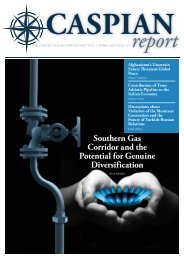You also want an ePaper? Increase the reach of your titles
YUMPU automatically turns print PDFs into web optimized ePapers that Google loves.
gas, which increased by 18.3% and<br />
reached 69.2 bcm in 2007, its import<br />
dependence is expected to increase<br />
rapidly due to rising gas demand.<br />
Despite the rapid increase in consumption,<br />
the share of natural gas in<br />
China’s energy mix is still relatively<br />
low at 3.5%, while coal accounts for<br />
69.5%. Natural gas consumption per<br />
capita amounted to a mere 53 cubic<br />
meters in 2007, compared with the<br />
world average of about 460 cubic<br />
meters. In order to promote the use<br />
of this “cleaner energy” as a substitute<br />
fuel for oil and coal, the government<br />
aimed to increase the share of<br />
natural gas in China`s total primary<br />
energy consumption (TPEC) up to<br />
10% by 2020. 27 Although natural<br />
gas production and use is rapidly increasing<br />
in China, it only comprised<br />
4% of the country’s total primary<br />
energy consumption in 2011. Heavy<br />
investments in upstream development<br />
and greater import opportunities<br />
are likely to underpin the significant<br />
growth in China’s natural gas<br />
sector. China contains several natural<br />
gas-producing regions, including<br />
the western and central parts of the<br />
country as well as offshore basins.<br />
While eager to develop older natural<br />
gas fields, China’s oil companies are<br />
exploring new areas such as deep<br />
water, shale gas, and gas derived<br />
from coal seams. The country’s first<br />
deep water field is expected to come<br />
online by <strong>2014</strong>. China continues<br />
to invest in natural gas pipeline infrastructure,<br />
to link the production<br />
areas in the western and northern<br />
regions of the country with demand<br />
centres along the coast, and to accommodate<br />
greater imports from<br />
Central Asia and Southeast Asia. 28<br />
This rapidly increasing energy demand,<br />
especially for liquid fuels, has<br />
made China extremely influential in<br />
world energy markets. 29 For China,<br />
the implied price is crucially below<br />
the Asian cost of importing liquefied<br />
natural gas (LNG), an alternative<br />
energy source it is developing. In<br />
other words, there is China’s need<br />
for a secure supply of gas. China<br />
routinely talks about reviving the<br />
Central Asia “Silk Road” trade corridor<br />
that is a geographical broadside<br />
to Russia, with its own ambitions to<br />
act as a bridge between Asia and Europe.<br />
Today, China has strengthened<br />
its position in the gas market. It has<br />
funded and built a pipeline system<br />
to supply itself with gas from Turkmenistan<br />
via Uzbekistan and Kazakhstan.<br />
Indeed, China agreed on a<br />
target to import 65 bcm per year of<br />
Turkmen gas by 2016. China is said<br />
to be unwilling to pay Russia more<br />
than it pays to Turkmenistan. Secondly,<br />
China knows that, thanks to<br />
events in Ukraine, Russia’s position<br />
in Europe is not as strong as it has<br />
been. Thus China is progressively<br />
gaining economic and political influence,<br />
which will help it to sign strategic<br />
partnership agreements with<br />
all the countries of Central Asia. (See<br />
Figure IV)<br />
If China needs to make a choice<br />
which option holds more advantages<br />
At the macro-economic level,<br />
China remains very much aware that<br />
bilateral trade with the US is three<br />
times greater than its trade flows<br />
with Russia. Considering Washington’s<br />
possible reactions, China is<br />
still aiming to build and maintain<br />
a major power relationship with<br />
the US economy, which remains<br />
99<br />
CASPIAN REPORT, FALL <strong>2014</strong><br />
27.<br />
Obuyuki Higash: “Natural Gas in China Market evolution and strategy”, International Energy Agency,<br />
Working Paper Series, June 2009, http://www.iea.org/publications/freepublications/publication/nat_<br />
gas_china.pdf.<br />
28.<br />
http://www.eia.gov/countries/country-data.cfmfips=ch<br />
29.<br />
“China”, http://www.eia.gov/countries/cab.cfmfips=ch










